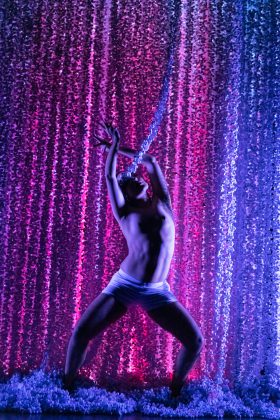Jasmine.
It might simply be a pretty flower in the Western gaze, but in South Asian cultures, especially in South India, the jasmine is replete with connotations of youth, sensuality, sexual awakening, and delicate femininity.
Just as the jasmine expresses a multilayered meaning, so does the Indic dancing body. And in their new show ‘Third Nature’, Raina Peterson and Govind Pillai (In Plain Sanskrit, Bent Bollywood) meld these two in a joyous, sensuous, and vulnerable celebration of the non-binary, ungendered, uncolonised body.

Instead of examining deloconisation, this show – in an entrancing departure from other contemporary South Asian dance work – celebrates a state in which the body is utterly free, a time before we as people of colour, as colonised people, and people of varied and fluid gender identities, were bound and corseted into hard notions of dual gender, cautious sexuality, Eurocentric ‘propriety’, and Victorian guilt. Using their respective dance vocabularies of Mohiniyattam, and a seamlessly blended soundtrack of popular and traditional Indian music, and, most of all, sprawling, abundant garlands of jasmine hung from the stage ceiling and piled on the stage itself, Peterson and Pillai create a world of enchantment, fantasy, and above all, unfettered, joyous pleasure.
Bare-chested, clad in only simple white shorts, the pair explore the possibilities that the jasmine – as much a third performer in this show as a beautiful, fantastical prop – offers them, separately and together. Pillai’s hand reaches through the jasmine, shaping itself into dance ‘mudras’, beckoning to Peterson. Peterson’s character entices Pillai’s into enjoying the touch of jasmine on the body. And at the piece’s peak, the pair began to tear down the jasmine garlands, laughing, kissing, throwing them at one another, winding them around each other’s bodies, tussling with one another through riotous piles of flowers, in a game of pure sexual liberation and joy.
This part of the show struck me not just for the raucous, melodic celebration of identity and self, but as an evocation of the ‘divine pleasure’ that Indic dance often celebrates. The destructive workings of colonialism and nationalism meant that today in Indic dance and music, transportative bodily pleasure is almost exclusively reserved for the portrayal of gods and goddesses. After all, jasmine is also a flower that is used to decorate – in fact often envelop – divine bronze bodies in temples or private shrines. But Peterson and Pillai re-inscribe divine pleasure onto their own human bodies, and in doing so they free them, and us, from the falsehood that to be human is to be limited.

The other highlight, for me, was the solo, improvised, expressive section Peterson performed, after the jasmine revels ended in sudden fall and depression. Evoking the withering of the flower with hands and face, they harnessed the deeper potential of the Indic dance body and its emotional expression (called ‘abhinaya’ or ‘bhav’). This particular kind of expression has a unique power – it allows the dancer to tell multiple, fleeting, intense stories at once, through the play of expression, the pathos of the hands.
Peterson’s character is saved from their melancholy by Pillai’s, who, rising from their sleep/depression, reaches out across the drifts of jasmine to them.
There is hope. Our abundance is not lost. We have no limits. And we can give ourselves permission to play.







